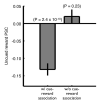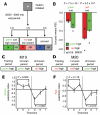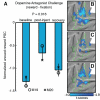Dopaminergic reward signals selectively decrease fMRI activity in primate visual cortex
- PMID: 23522051
- PMCID: PMC3610182
- DOI: 10.1016/j.neuron.2013.01.008
Dopaminergic reward signals selectively decrease fMRI activity in primate visual cortex
Abstract
Stimulus-reward coupling without attention can induce highly specific perceptual learning effects, suggesting that reward triggers selective plasticity within visual cortex. Additionally, dopamine-releasing events-temporally surrounding stimulus-reward associations-selectively enhance memory. These forms of plasticity may be evoked by selective modulation of stimulus representations during dopamine-inducing events. However, it remains to be shown whether dopaminergic signals can selectively modulate visual cortical activity. We measured fMRI activity in monkey visual cortex during reward-only trials apart from intermixed cue-reward trials. Reward without visual stimulation selectively decreased fMRI activity within the cue representations that had been paired with reward during other trials. Behavioral tests indicated that these same uncued reward trials strengthened cue-reward associations. Furthermore, such spatially-specific activity modulations depended on prediction error, as shown by manipulations of reward magnitude, cue-reward probability, cue-reward familiarity, and dopamine signaling. This cue-selective negative reward signal offers a mechanism for selectively gating sensory cortical plasticity.
Copyright © 2013 Elsevier Inc. All rights reserved.
Figures









References
-
- Adab HZ, Vogels R. Practicing coarse orientation discrimination improves orientation signals in macaque cortical area v4. Curr Biol. 2011;21:1661–1666. - PubMed
-
- Bao S, Chan VT, Merzenich MM. Cortical remodelling induced by activity of ventral tegmental dopamine neurons. Nature. 2001;412:79–83. - PubMed
Publication types
MeSH terms
Substances
Grants and funding
LinkOut - more resources
Full Text Sources
Other Literature Sources
Medical

